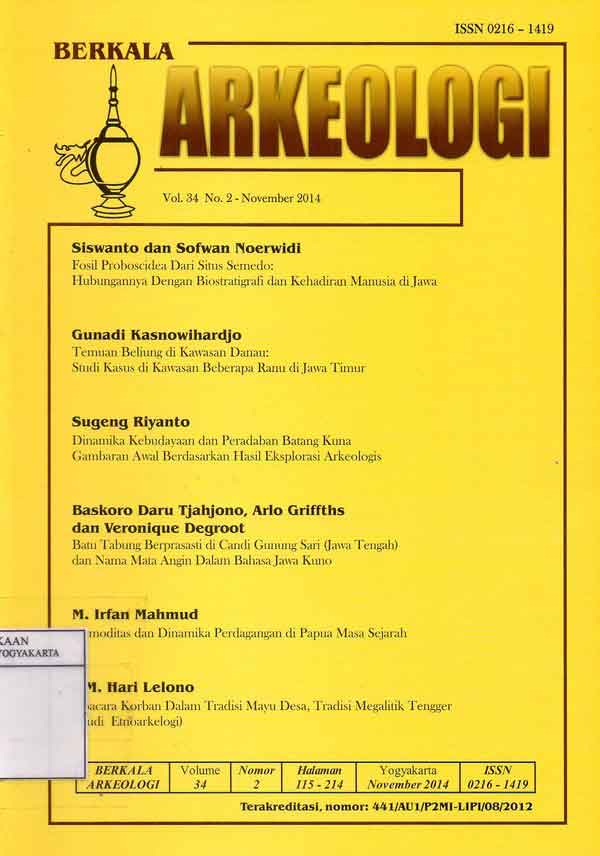UPACARA KORBAN DALAM TRADISI MAYU DESA, TRADISI MEGALITIK TENGGER (STUDI ETNOARKEOLOGI)
Main Article Content
Abstract
The tribe of Tengger, who lives in the surrounding of Mount Bromo - East java, is one of the tribes that still upholding the ancestral tradition. i.e. honoring the spirits of the ancestor. The question arises from this subject is what religious background that actually reflected through their daily activities, Hindu or Indonesia indigenous (Jawa)? The mystery revealed in one of the important rituals that only been held once every five years, the mayu desa ritual. Such ritual is also the main discussion of this article. An ethno-archeological approach was chosen to gain data and information because there are several menhirs and punden found on site and many ethnographical data still available to be observed. In this regards, a method consisted of observation and in-depth interview with whoever that considered would be able to provide information was applied. Through an analysis on a series of data, it is concluded that the animal offerings (a cow or a bull in ancient time) in the sacrificial ritual mayu desa is the central ritual in conducting the tradition of honoring the world of the spirits of the ancestor in each village of Tengger.
Article Details

This work is licensed under a Creative Commons Attribution-NonCommercial-ShareAlike 4.0 International License.
References
Adrianto, Ambar. 2010. Manusia Tengger, Kearifan Lokal di desa Ngadisari. Yogyakarta: Lembaga Penelitian dan Penerbitan “Prapancaâ€.
Atmosudiro, Sumiati. 1981. Bangunan Megalitik Salah Satu Cerminan Solidaritas Masa Perundagian dalam Berkala Arkeologi No II (1). Balai Arkeologi Yogyakarta. Hlm. 38.
Hefner, Robert W. 1999. Geger Tengger Perubahan Sosial dan Perkelahian Politik. Yogyakarta: LkiS.
______________ 1985. Hindu Javanese: Tengger Tradisition and Islam. Princeton: Princeton University Press.
Istari, Rita. 2009. “Arsitektur Candi Sanggar Di Lereng Gunung Bromo Kabupaten Pasuruan (Tahap IV)â€. Laporan Penelitian Arkeologi (LPA). Balai Arkeologi Yogyakarta.
Lelono, Hari. 2003. “Unsur-Unsur Kepercayaan Pada Bentuk Permukiman dan Rumah Tengger, Jawa Timur†dalam Berita Penelitian Arkeologi (BPA) No 18. Balai Arkeologi Yogyakarta. Hlm. 18.
__________ 1989. “Upacara Kalang Obong (Suatu Tinjauan Etnoarkeologi)†dalam Berkala Arkeologi X (1). Balai Arkeologi Yogyakarta. Hlm. 8.
Kremer, Carol (ed.). 1979. Ethnoarchaeology Implications of Ethnography for Archaeology. The Idea of Etnoarchaeology: Not and Comment. New York: Columbia University Press.
Nancy, JS. 1985. Japa Mantra Hindu Kuno Dalam Tradisi Tenger. Jakarta: Antropologi-Universitas Indonesia.
Soejono, R.P, 1984. Jaman Prasejarah di Indonesia, Sejarah Nasional Indonesia I. Edisi ke-4. Jakarta: Departemen Pendidikan dan Kebudayaan. Hlm. 247.
Sutarto. 2001. Di Balik Mitos Gunung Bromo Tentang Orang Tengger dan Tradisinya. Dinas Pariwisata Propinsi Jawa Timur.
Wagner, F.A. 1962. “Indonesia: The Art of an Island Group†dalam Art of the World Series.

